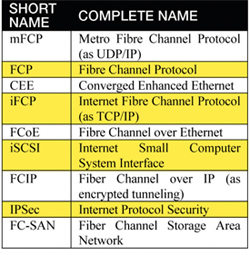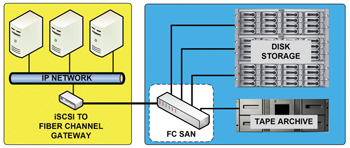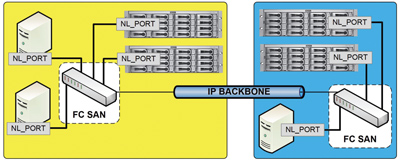Understanding IP Storage

Since the early 2000s, the storage industry has been at pains to develop an alternative to Fibre Channel for storage networks based on Ethernet and IP, which became known as "IP storage."
Well known and widely deployed, the familiar Fibre Channel has evolved to a gigabit or multi-gigabit speed networking technology primarily used in the implementation of Storage Area Networks (SANs). The more recent search for suitable solutions in IP storage grew out of those Fibre Channel standards and protocols, and has thus enabled the transmission of storage data traffic over TCP/IP.
In relation to IP storage, Fibre Channel (FC) has advantages in that it is very efficient in part due to its integrated protocol stack. TCP/IP, on the other hand, has a serious level of protocol overhead that adds complexities to its utilization in storage networking applications.
The use of IP storage technologies is barely half a decade old, and thus the variants and implementations are at best a niche market searching for more widespread acceptance. Nonetheless, the concepts for IP storage make sense as we expand the global reach of networked storage environments.
The family of IP storage includes Fibre Channel over Internet Protocol (FCIP), Internet SCSI (iSCSI), and Internet Fibre Channel Protocol (iFCP). Introducing IP storage brings with it several acronyms that are typically found in the storage networking community, and share like acronyms (see Table 1) to those in other parts of industry.
For example, in this article, FCP will reference "Fibre Channel Protocol" and not the more familiar "Final Cut Pro" (aka FCP) that we see routinely in the media and entertainment space.
Another is Fibre Channel over Ethernet (FCoE), a technology that allows the movement of Fibre Channel traffic over Converged Enhanced Ethernet (CEE). As with any technological terminology, there can be confusion and misrepresentation—such as when IP storage was erroneously referred to as 'Storage over IP' (SoIP), a branded product line from Nishan Technologies around 2003. One should probably not confuse this SoIP brand with the overall concepts of IP storage as a technology with standardized approaches to implementation.

Table 1: IP storage uses acronyms typically found in the storage networking community.CONNECTION MEDIUM BETWEEN SERVERS
To begin our overview of IP storage, we start with iSCSI, which in concept is the transport of the SCSI protocol over TCP/IP. iSCSI, ratified by the Internet Engineering Task Force (IETF) in 2003, takes a similar approach to Fibre Channel SAN (FC-SAN) in that both iSCSI and FC-SAN must be installed in the operating system as a device driver, except with iSCSI the typical SCSI-cable is replaced with an Ethernet-based TCP/IP connection.
In the early implementations of iSCSI (circa mid-2000), the deployment of iSCSI was primarily as a connection medium between servers and Fibre Channel storage via an interface called an iSCSI-to-Fibre Channel gateway (see Fig. 1).
The next protocol, "Internet Fibre Channel Protocol (iFCP)," defines a mapping of Fibre Channel Protocol (FCP) on TCP/IP. The rationale for iFCP is rooted in protecting the investment the industry had already put into Fibre Channel-based storage area networking. iFCP was designed as a means to replace the FC-network infrastructure with an IP/Ethernet infrastructure, thus reducing the cost impacts of an exclusively Fibre Channel-based buildout for interconnection of storage islands or architectures.
Officially recognized by the IETF as RFC 4172, iFCP was ratified in 2005. As an Internet Protocol for Internet Fibre Channel Storage Networking, iFCP provides an architecture and a gateway-to-gateway approach for Fibre Channel fabric functionality between Fibre Channel devices over an IP network. iFCP currently is available in 1 Gbps, 2 Gbps, 4 Gbps, 8 Gbps and 10 Gbps variants (see Fig. 2).
DISTANCE LIMITATIONS REMOVED
Lastly, Fiber Channel over IP (FCIP or FC/IP), as defined in IETF RFC 3821 and ratified in 2004, is designed to remove the distance restrictions of Fiber Channel, effectively an alternative to wide area network (WAN) technologies.

Fig. 1: iSCSI to Fibre Channel interfaced between an IP network and Fibre Channel SAN FCIP is a point-to-point transmission routing technology that uses a tunneling protocol to connect two Fiber Channel SANs over a TCP/IP routing topology. FCIP is completely hidden from the Fibre Channel switches of the SAN. It is further used to make SAN islands appear like a single large storage area network.
When compared to conventional Fibre Channel networks, FCIP can utilize data traffic encryption between the local IP routers of the SAN by means of Internet Protocol Security (IPSec), a protocol suite for securing IP communications that encrypts and authenticates each IP packet of the data stream.
The tunnel protocol mode used for FCIP is akin to a Virtual Private Network (VPN). FCIP will first encrypt and/or authenticate the entire IP packet (i.e., both the data payload and the IP header); then it encapsulates it into a new IP packet with a new IP header. This is the same tunnel mode concept used in creating network-to-network communications (e.g. between routers to link sites), host-to-network communications (e.g. remote user access), and host-to-host communications (e.g. private chat)—but is now applied to IP storage networks.
ADVANTAGES AND DISADVANTAGES
The pluses of utilizing TCP/IP and IP storage in relation to Fibre Channel include its familiarity, maturity and greater utilization. TCP/IP is fueled by a greater knowledge base and implementation as compared with Fibre Channel. The cost of TCP/IP and thus IP storage is still less than that of Fibre Channel. Its administration tools are more widely available and TCP/IP is not encumbered by distance.
On the negative side, given the infancy of IP storage, there remains concern over interoperability issues and some say a lack of standardization voiced primarily by those that were early adopters. The overhead requirements imposed in TCP/IP and the reduced capabilities to carry mass amounts of data add to more issues such as the high latency in TCP/IP/Ethernet switches. Furthermore, there are higher CPU use requirements for SAN data traffic when using TCP/IP, which becomes evident as traffic and file sizes escalate in size.

Fig. 2: iFCP utilizes an IP backbone to interface between Fibre Channel SANs Today, the Fibre Channel SAN retains itself as the preeminent solution for networked storage. However, IP storage is an evolving technology with a growing set of flavors from which to choose from. Remember, too, that implementation for data-centric or transactional business requirements has a different agenda set than those of the moving media industry.
Deeply entrenched in the media industry is the need for a continuous collaborative workflow with variable dynamics, which are quite different than that of a database model. Thus, the choice of the protocol and transport technologies hinges deeply on the applications employed.
Finally, and just at the edge of the horizon, we find transmission rates between storage sites and even among the local storage infrastructures already reaching above 10 Gbps. The emerging widespread acceptance of these new topologies accelerates the deployment of extremely high-speed/high-bandwidth network subsystems such as Infiniband, which replaces the PCI-bus with that of a serial network.
Videoserver manufacturers are already utilizing Infiniband technologies in their storage systems, incorporating them integrally into their chassis or when connecting large frames of storage drives to form single volume stores. For an even more far reaching discussion, Virtual Interfaces (VI) and Remote Direct Memory Access (RDMA) are further examples of network storage technologies that employ TCP/IP-centric architectures that I hope to explore in upcoming articles.
Karl Paulsen is chief technology officer for AZCAR Technologies. Karl is a SMPTE Fellow, SBE Life Member and Certified Professional Broadcast Engineer. Contact him at karl.paulsen@azcar.com.
Get the TV Tech Newsletter
The professional video industry's #1 source for news, trends and product and tech information. Sign up below.

Karl Paulsen recently retired as a CTO and has regularly contributed to TV Tech on topics related to media, networking, workflow, cloud and systemization for the media and entertainment industry. He is a SMPTE Fellow with more than 50 years of engineering and managerial experience in commercial TV and radio broadcasting. For over 25 years he has written on featured topics in TV Tech magazine—penning the magazine’s “Storage and Media Technologies” and “Cloudspotter’s Journal” columns.
